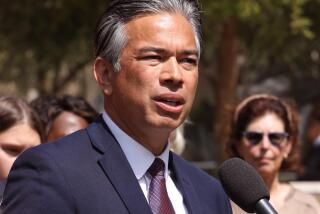Port hopes to move facilities that pose risk
- Share via
After a quarter century of promises to Wilmington and San Pedro residents, the Port of Los Angeles on Thursday unveiled plans to move facilities that handle dangerous cargo to Terminal Island, which could reduce the risk for populated areas of the harbor.
If approved by the Harbor Commission, the plan, which might take years to develop, would relocate and consolidate some of the port’s nine marine terminals for crude oil, natural gas, refined petroleum products and volatile chemicals.
Many of the facilities are either obsolete or expose nearby neighborhoods and commercial areas to the threat of explosion, fire and toxic releases.
Harbor officials say the move would allow the older cargo operations, including a few dating from the 1920s, to move to modern terminals equipped with the latest safety measures.
David Mathewson, the port’s planning director, said he hoped the plan would ease the tension between harbor officials and residents who have long complained about the risks of hazardous shipments.
“We understand the public concern about this,” Mathewson said. “Although the existing facilities are consistent with our risk management plan, there are land-use incompatibilities” with the surrounding community.
Geraldine Knatz, the port’s executive director, presented the Terminal Island plan during Thursday night’s commission meeting.
The proposal reserves an area for hazardous cargo facilities on the east side of Terminal Island that borders the Port of Long Beach.
Mathewson said the amount of acreage had not been determined nor the number of hazardous cargo operations that would be moved.
Relocating the oil and chemical terminals is part of a broader plan to remake Terminal Island, including the revitalization of Fish Harbor to bolster the commercial fishing industry.
The other proposals call for new wharves, container terminals, expanded rail facilities, and the removal of the Los Angeles Export Terminal, a defunct petroleum coke operation.
“All of this is conceptual at this point,” Mathewson said. “We still have a lot of homework to do.”
The goal of moving chemical and oil terminals to an island facility dates to 1980, when port officials added it to the harbor master plan to improve community safety.
Four years earlier, nine people were killed and 58 injured when the tanker Sansinena exploded at the Union Oil Terminal. The blast rattled buildings more than 45 miles away.
In 1972, a fire at the heavily contaminated GATX Annex Terminal destroyed 17 chemical storage tanks, injured 50 firefighters and contaminated 1 1/2 acres at 22nd and Miner streets.
For years, the port had plans to relocate and consolidate hazardous terminals on Pier 400, a 590-acre island to be created by dredging the harbor bottom. The proposal was known as “energy island.”
But after two decades of work, port officials turned virtually all of Pier 400 into a giant container terminal for Maersk Inc., the world’s largest shipping line. About 15 acres of the island remain for oil, gas and chemical terminals, far less than the original plan for 265 acres.
Community activists and neighborhood association leaders have considered the change in Pier 400’s use an act of betrayal by harbor officials.
“The port made a commitment in its master plan 26 years ago, then went in a direction that served its own self-interest,” said Janet Schaaf-Gunter, treasurer of the San Pedro Peninsula Homeowners Coalition.
“If this effort is sincere,” Schaaf-Gunter said, “I hope someone keeps a gun to their head. Otherwise, they could renege on this promise too.”
Over the years the number of cargo terminals that handle hazardous shipments has been reduced from 17 to nine. Some have closed or moved out of the harbor. The port also has worked with tenants to reduce the risk of explosion, fire and toxic releases.
Despite assurances that safety has improved, community activists say the terminals remain a threat to neighborhoods and should be relocated to safer locations.
In July, a tanker loaded with fuel additive experienced problems with its safety system while at berth, forcing a temporary shutdown of a nearby container terminal.
Earlier this year, the State Lands Commission, which oversees coastal areas, issued a report stating that the more than 80-year-old Valero and Exxon Mobil terminals were in poor condition and at high risk of a major spill during an earthquake.
More to Read
Sign up for Essential California
The most important California stories and recommendations in your inbox every morning.
You may occasionally receive promotional content from the Los Angeles Times.











